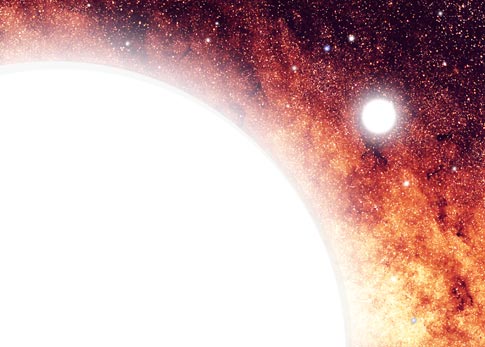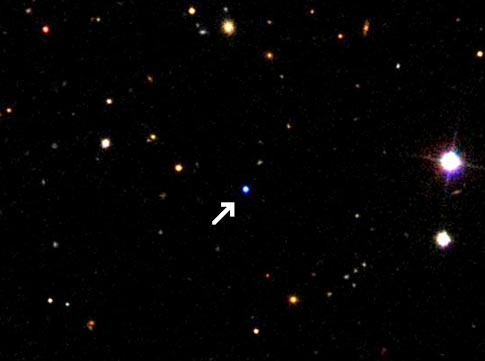Key Takeaways:
Astronomers have found the lowest mass white dwarf known in our galaxy: a Saturn-sized ball of helium containing only about one-fifth the mass of the Sun. In addition, they have spotted the source of the white dwarf’s radical weight-loss plan. An unseen companion, likely another white dwarf, has sucked away much of the tiny white dwarf’s material, leaving it a shadow of its former self.
“This star is bizarre,” said Warren Brown of the Harvard-Smithsonian Center for Astrophysics. “It takes extraordinary circumstances to make such a low mass white dwarf.”
When a Sun-like star ages and dies, it becomes a white dwarf. The newfound white dwarf, with the unwieldy designation of SDSS J091709.55+463821.8 (hereafter J0917+46) lies about 7,400 light-years from Earth near the border of the constellations Lynx and Ursa Major. Where a typical white dwarf holds about half a Sun’s worth of material, the newfound white dwarf contains only a fraction of that mass.
When the astronomers first found J0917+46, they predicted that it must have an unseen companion that had aided its weight loss. A subsequent radial velocity search, which looked for signs that the white dwarf wobbled when tugged by a companion’s gravity, confirmed the prediction. The astronomers ruled out the possibility that the companion is either a low-mass main sequence star or a black hole. It must be either another white dwarf or a neutron star, with a white dwarf being the more likely candidate.
“No star is old enough to produce such an extremely low-mass white dwarf by itself,” explained Brown. “Therefore, we knew that mass must have been stripped from the white dwarf by a companion.”
“Finding the companion means that stellar evolution theories have passed a major test,” added co-author Scott Kenyon of the Smithsonian Astrophysical Observatory. “The fact that the companion is a more massive white dwarf or neutron star is also consistent with theory.”
The team also described the oddball pair’s history. This binary system began with one star about twice the mass of the Sun and a second star slightly less massive than the Sun. The more massive star was the first to evolve, becoming a white dwarf weighing perhaps one-third as much as the Sun. Ten billion years later, its companion became another white dwarf. In each step, the puffed-up outer layers of the evolving star enveloped the companion, causing friction that moved the two stars closer together. They now orbit each other every 7.6 hours at a distance of about 650,000 miles and a stunning speed of 335,000 miles per hour.
“The relation between our white dwarf and its companion is like a cosmic marriage in which both people have to give a lot,” said Kilic. “Two stars start out close to each other. One of them engulfs the other (like a hug) and gives continuously (losing mass), and they get closer. Then the other star evolves and becomes a giant and engulfs the first star (hugging back) and now it has to give a lot, or lose a lot of mass. They get closer and closer and end up dancing continuously.”
The astronomers predict that the two white dwarfs eventually will merge. However, that merger will not take place for 10 billion years or more.











